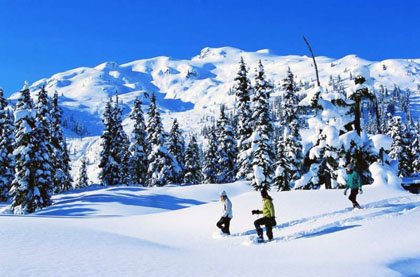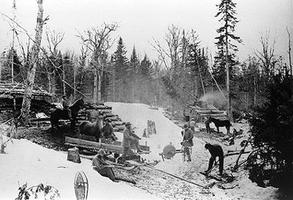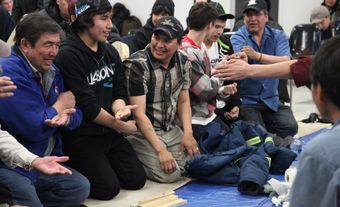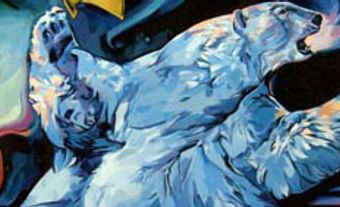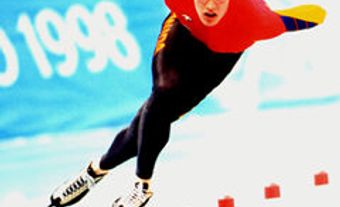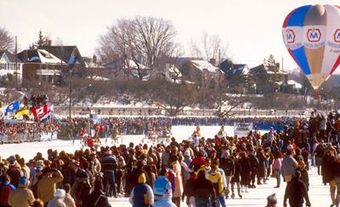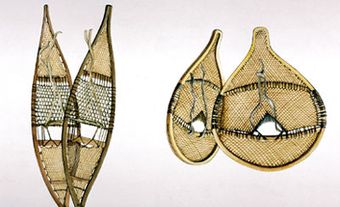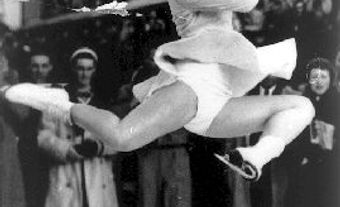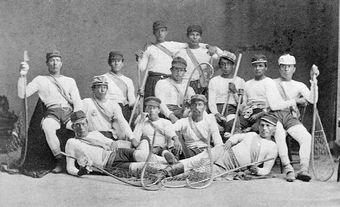Snowshoeing is a form of physical activity that uses two wooden-frame "shoes," each strung together with interlaced webbing, to walk or run over snow. Snowshoeing has become a popular pastime among Canadians.
Early History
Snowshoeing was a common form of transport, and probably of sport, among Indigenous peoples prior to European settlement in North America. Indigenous peoples crafted their own snowshoes out of wood and rawhide. Later, snowshoeing was adopted by fur trappers and then settlers.
Snowshoeing: From Pastime to Sport
Long-distance "tramps" were a common form of snowshoeing activity in the 1840s. In 1843, twelve English-speaking men from Montreal, who met regularly to tramp or hike on snowshoes on Saturday afternoons, formed the Montreal Snow Shoe Club (MSSC) – the first of its kind in the world. Nicholas "Evergreen" Hughes was a key figure in organizing the club and in the growth of snowshoeing itself. Some of the founders were prominent Montreal businessmen.
Men from the MSSC and a handful of other clubs would rendezvous near McGill College to tramp 19 km or more, following the club's senior officer in single file. At the rear of the line was the "whipper-in," an accomplished snowshoer whose job was to keep the pack together. Halfway through, or after these tramps, the snowshoers rested their feet at a local chophouse or tavern in the city or atop Mount Royal. The members ate meals, sang songs such as "Rise, Ye Sons of Canada" and "Partant pour la Syrie", recited poems and danced cotillions.
Race meetings were held as early as 1843 and featured dashes, 2-mi (3.2 km) events and hurdles over 4-ft (1.2 m)-high barriers. There is good evidence that the hurdle race in snowshoeing preceded its summer counterpart by almost a decade. (Similarly, the word "jogged" was used to describe the slow, chugging motion of trampers during the early 1870s.) Prior to the Second World War, track athletes used the snowshoe as a winter training device in the absence of good indoor training venues.
Clubs and Competitions
By the late 1860s, the number of snowshoe clubs and race meetings in Montreal had grown. The increased interest in competition was also reflected in prestigious trophies such as the Tecumseh Cup; in new events such as the mountain steeplechase; in the appearance of outstanding competitors, especially the fleet-footed Keraronwe and W.L. Maltby; and in improved times in all events (1.6 km in 6 min became common). Other advancements include the introduction of the 1.5-pound (0.68 kg) racing shoe that replaced the old regulation "four-pounder", and the birth of competitive clubs in Ottawa, Toronto and Quebec City.
Snowshoe races featured by skating rinks were now often their premier event at annual races. The development of a snowshoe-racing vocabulary also shows its popularity; for example, the term "brush," referred to a successful acceleration of one racer past another. By the early 1880s, snowshoeing was clearly the most popular winter amusement.
Clubs were in evidence from Winnipeg to Terra Nova, Newfoundland. The MSSC was instrumental in forming the multisport Montreal Amateur Athletic Association in 1881 and, along with other Montreal snowshoe clubs, organized, promoted and staged the world-famous, week-long winter Mardi Gras or carnival from 1883 to 1889.
Snowshoers gave concerts, engaged in campaigns to raise charity funds and organized pedestrian clubs in the summer. In facing the rigours of long tramps, frostbite, bleeding toes and the ever-present side stitch, snowshoers displayed a particularly Canadian example of the 19th-century sporting phenomenon called "muscular Christianity."
A skating resurgence in the 1890s and fanatical interest in a new winter sport, ice hockey, halted and reversed the growth and development of snowshoeing.
Winnipeg became the centre of the sport during the early 20th century. The Canadian Snowshoe Union, formed in 1907, regulated the sport's 70 modern clubs.
Snowshoeing Today
Snowshoeing remains a popular Canadian pastime as well as a competitive sport. Founded in 2010, the World Snowshoe Association (formerly the International Snowshoe Federation) is the international organization that oversees snowshoe racing. Canadian and international athletes participate in snowshoeing competitions in both the Special Olympics and Arctic Winter Games.

 Share on Facebook
Share on Facebook Share on X
Share on X Share by Email
Share by Email Share on Google Classroom
Share on Google Classroom

